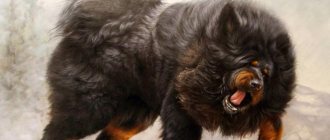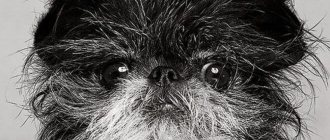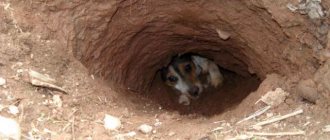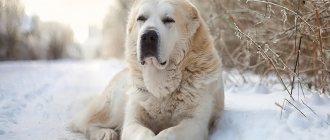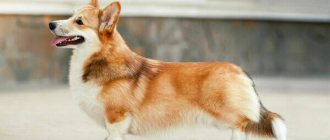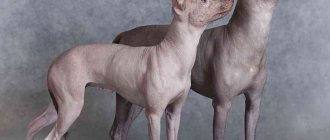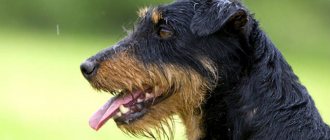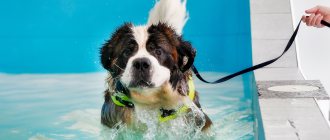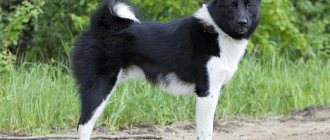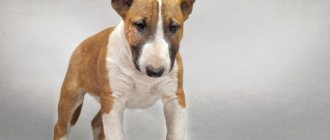Breed standard and description
There is no separate standard for males and females, as the differences are minor.
Height at withers: 25 to 30 cm
Weight: from 4 to 6 kg
Color:
- Black and deep red,
- Black and light red,
- Chocolate and rich red,
- Chocolate and light red,
- Ginger,
- Red deer.
additional characteristics
- Experts believe that the best proportion in the physique of miniature pinschers is when the length and height of the body are approximately the same.
- The size of the muzzle should be half the length of the body from the nape to the base of the tail.
- The miniature should not have too long legs, and the skull should not be round.
- The eyes are only dark, oval in shape, it is desirable that the eyelids are painted black.
- The ears are erect or curled at the ends.
- The nose is black.
- In addition, the dog should not walk excessively as this is a disqualifying sign.
Cupping
There used to be a strict requirement by all associations for tail docking , partly because working dogs were often attacked for their long tails due to their mobility.
Now in many countries this action is considered unnecessarily cruel and dogs with long tails are allowed into exhibitions. If you prefer to dock your tail, then the optimal age for this is 3-5 days . At this time, the puppy's nervous system has not developed enough to feel pain.
FCI Breed Standard No. 185 /04/06/2000/
Dwarf Pinscher (Miniature Pinscher)
COUNTRY OF ORIGIN: Germany PUBLICATION DATE OF PREVIOUSLY VALID STANDARD: 02/02/1995 APPLICATION: Domestic dog and companion. FCI CLASSIFICATION: Group 2. Pinschers and Schnauzers-Molossians-Swiss Shepherds and others. Section 1. Pinschers and schnauzers. No performance tests. BRIEF HISTORICAL SUMMARY: Miniature Pinschers were kept in large numbers already at the beginning of the century, and the Stud Book for 1925 records no less than 1300 entries. Like the German Pinscher, of the many color options, only black and tan and red (murugi) were considered breed varieties. General appearance: The Miniature Pinscher is a smaller image of the German Pinscher without any signs of dwarfism. His elegant, square build is clearly visible thanks to his short, smooth coat. IMPORTANT PROPORTIONS: The ratio of the oblique length of the body to the height makes the appearance as square as possible. The length of the head (from the tip of the nose to the occipital protuberance) is equal to half the length of the topline (from the withers to the base of the tail). Behavior and Temperament: Lively, energetic, self-confident and balanced. These qualities make him a pleasant family dog and companion. HEAD CRANIAL REGION: Skull: strong, oblong, without a clearly protruding occipital protuberance. The forehead is flat without wrinkles, parallel to the bridge of the nose. Transition from forehead to muzzle: Slight, but clearly defined. Facial part: Nose: The nasal planum is well developed and black in color. Muzzle: Ends in a blunt wedge. The bridge of the nose is straight. Lips: Black, smooth and fitting close to the jaws. The corners of the lips are closed. Jaws/teeth: Strong upper and lower jaws. A complete scissor bite (42 pure white teeth according to the dental formula) is in a strong and tight occlusion. The chewing muscles are strongly developed without protruding cheekbones that interfere with the smooth contour. Eyes: Dark, oval, with close-fitting eyelids, pigmented black. Ears: Set high, erect or pendulous, triangular. In drooping ears, the inner edges fit tightly to the cheekbones, turned forward towards the temples. The folds of the ears are parallel and should not be higher than the skull. Neck: Nobly arched, not too short. Smoothly blends into the withers without any indication of the base. Dry, without dewlap or dewlap. The skin on the throat is tight-fitting, without folds. BODY: Topline: Slightly sloping from withers to tail. Withers: Forms the highest point of the topline. Back: Strong, short and tense. Loin: Strong. The distance from the last rib to the hip is short to give the dog a compact appearance. Croup: Slightly rounded, merging imperceptibly into the base of the tail. Chest: Moderately broad, oval in cross-section, reaching to the elbows. The forebreast (front of the chest) is clearly marked by the sternum. Underline and Belly: The groin is not too tucked in, forming a gently curved line with the underside of the chest. Tail: Natural (docked in some countries) LIMBS Forequarters: When viewed from the front, the forelegs are strong, straight and not narrowly set. When viewed from the side, the forearms are straight. Shoulders: The shoulder blades fit close to the chest and are very muscular on both sides of the scapula, projecting above the thoracic vertebrae. As oblique as possible, form an angle of approximately 50o to the horizontal. Shoulder bones: Close to the body, strong and muscular, forming an angle of 95-100o (humeral-scapular). Elbows: Correctly tucked in, not tucked in or turned out. Forearms: Strongly developed and muscular. Completely straight when viewed from the front and side. Wrists: Strong and strong. Pasterns: Strong and springy. When viewed from the front, they are vertical; when viewed from the side, they are slightly inclined. Forelegs: Short and round, toes closed and arched (cat feet), nails short, black and strong. Hindquarters: Set sloping when viewed from the side, parallel but not narrow when viewed from behind. Hips: Moderately long, wide, very muscular. Knees: Turned neither in nor out. Lower thighs: Long and strong, sinewy, leading into strong hocks. Hocks: Well angulated, healthy and strong, turning neither in nor out. Metatarsus: Sheer. Hind legs: Slightly longer than forelegs. The fingers are closed and arched. The claws are short and black. Movement: The Miniature Pinscher is a trotter. His back remains strong and stable in movement. Movement is harmonious, confident, strong and free with good stride length. A sweeping trot is typical, movements are effortless, smooth, with a strong drive and free reach of the forelimbs. SKIN: Tightly fitting all over the body. COAT: Coat: Short and dense, smooth, close-lying and shiny, without bald patches. COLOR: Solid: reddish brown to dark reddish brown. Black and Tan: Lacquer black with red or brown markings. The markings should be as dark, rich and well-defined as possible. The markings are distributed as follows: above the eyes, on the throat, on the pasterns, on the paws, on the inside of the hind legs and under the base of the tail. Two identical, clearly separated triangles on the chest. HEIGHT AND WEIGHT: Height at withers: Males and females 25-30 cm. Weight: Males and females 4-6 kg. DEFECTS: Any deviation from the above points should be regarded as a defect or defect depending on the degree of severity. ESPECIALLY: Rough or light build. Too squat or too upturned on the legs. Rough or rounded skull. Wrinkles on the forehead. Short, pointed or narrow muzzle. Direct bite. Light, too small or too large eyes. The ears are set low or very long and are not carried equally. Suspension. The back is too long, arched or soft. Humped back. Beveled croup. Long paws. Amble. Prancing step (hackney). Sparse, fine wool. Tiny white flecks, a black strap on the back, a dark saddle cloth and a light or fawn coat color. Deviation from standard height up to 1 cm. Serious defects (defects): Unexpressed sexual type. Very easy build. Apple-shaped head. The lines of the forehead and muzzle are not parallel. Twisted elbows. Hind legs placed under the body. Straightened angles of the hind legs (straight rear). Turned out hocks. Deviation from standard height is more than 1 cm, but less than 2 cm. Disqualifying defects: Underdevelopment of any kind. Lack of breed type. Defects of the mouth, such as underbite, or overbite, or misalignment of the jaw. Serious defects in individual articles, such as defects in structure, coat and color. Deviation from standard height of more than 2 cm. Cowardice, aggressiveness, malice, obvious distrust or nervous behavior. NOTE: Males must have two apparently normal testes fully descended into the scrotum.
History of the Miniature Pinscher breed
Basically, information about the breed is based on oral German literature, which was later transferred to books. These descriptions suggest that miniature pinschers were kept in castles for several centuries to get rid of rats and other small rodents.
During the heyday of German Gothic, this baby was called Reh Pinscher . Reh is the name of a miniature deer that was found in German forests at that time.
If we talk about Dobermans , the little one is much older than this breed . Dog lover Karl Friedrich Lewis Doberman gave up half his life to breed a miniature pinscher into a larger dog with the same appearance. The eternal debate “which came first: the egg or the chicken” arose due to the fact that the miniature dog was bred only in Germany, and then Mr. Doberman with the dog named after him began to travel to all canine associations, seeking recognition of the breed.
In many countries, the Doberman Pinscher was seen earlier than the Miniature Pinscher, therefore, when the Miniature Pinscher was brought into these areas, dog handlers considered it to be a derivative of the Doberman Pinscher that had already been seen earlier.
In 1895, German breeders created a breed club and developed a standard. Ming Pin (the name of the breed in foreign countries, derived from the abbreviation of miniature pinscher) was first exhibited in 1900.
Before the First World War, the popularity of the breed grew, and miniature dogs began to be actively bred in Scandinavian countries. In 1919, the babies were brought to America, and already in 1929 the American breed club was formed.
Until 1930, miniature dogs were exhibited in the terrier group, but then they were reclassified into the toy dog group. Then, in addition to the German name, they were assigned the name - miniature pinscher.
Miniatures are classified as domestic dogs and companion dogs.
History of the breed and homeland of origin
The Miniature Pinscher is a native of Germany. The first mention of the breed dates back to the 15th century. Dog handlers have established that dogs of this breed began to be bred by farmers in Württemberg. The Germans kept miniature assistants at the stables with top-class horses. There were always a lot of rats in the stalls, and the pinschers exterminated them almost with lightning speed.
For their endurance, agility and fearlessness, the dogs were nicknamed “the thunderstorm of the stables.” Later, hunters began to take them to catch birds, rabbits and other small animals. The mini dog ate very little and remained active, which suited everyone. In addition, the loud barking scared away large animals along the road.
Towards the end of the 19th century, the miniature pinscher seriously captivated dog handlers. In 1878, at the Hanover Exhibition, the breed was shown in all its glory for the first time. Interest in previously little-known dogs has given rise to breeding research to produce miniature dogs that are even smaller in size.
As a result, a standard was developed in 1880. Miniature pinschers gained wide popularity and began to be used as companion dogs for urban keeping.
In 1895, the first breeders' club was opened in Germany. From here the mini-dogs were taken to an exhibition in France, after which the whole of Europe fell in love with the perky dogs. World wars repeatedly threatened the existence of the breed. But ardent pinscher lovers managed to preserve and redistribute these wonderful tailed animals.
Character and temperament
This is a proud and brave dog. Although its main purpose is hunting rodents , the miniature pinscher, without hesitation, will rush at the offender of the owner, even larger in size.
They treat children well , but will not tolerate disrespectful treatment, so you should not bring them together with children who are too young, who can pinch or hit: the miniature will respond to any painful influence.
Susceptible to small dog syndrome . They can allow themselves to try to influence their owners, justifying themselves by their small size. Therefore, miniatures should not be indulged in their desire to show character.
It is important that the Miniature Pinscher has a clear understanding of the rules and boundaries, then it will be the ideal companion.
Dog and man
Baby miniature is right for you if:
- Do you like walking, cycling or rollerblading;
- Your children are over five years old;
- There are no loopholes in your private home through which a dog can escape;
- You are active and full of energy.
is not suitable for you if:
- You are a homebody;
- You have very young children;
- You have other pets.
Maintenance and care
Despite the fact that the miniature pinscher looks like just a baby, he needs constant exercise : you need to walk him 2 times a day, for an hour if possible.
Miniature pinscher puppies are fed veal or chicken processed with boiling water, which make up 2/3 of the diet. You can include egg yolk and fish in your diet. The remaining 1/3 is made up of grains and vegetables. Then you can feed food for small dogs, but you need to switch gradually.
The coat does not require special care: comb once a week with a soft brush, and during the shedding period, wipe with a wet towel.
Miniature pinschers are not very adapted to cold weather: take care of warm clothes for your pet.
You need to regularly clean your ears and trim your nails. The miniature's eyes may become swollen; they need to be carefully cleaned with a cotton swab soaked in hydrogen peroxide.
Education and training
Zverg is very stubborn . Education needs to be done from a very early age. Despite their size, puppies often behave like large dogs: they try to attack strangers, show increased curiosity, and try to escape.
The playful nature of training is most suitable for miniature dogs. These are stubborn but sweet creatures who are ready to give in to their owner as soon as they sense him as a leader.
Miniature Pinscher: disadvantages of the breed
Despite the fact that miniatures are very convenient to maintain, they have some disadvantages:
- Miniature Pinschers rarely get along with other pets due to jealousy. Friendship with pets can only happen if they are introduced to them from an early age.
- The breed is prone to digging up everything. Flower beds, summer cottages, and flowers in pots suffer.
- They love to chew on everything - shoes, wires, papers, equipment. They may show dissatisfaction when trying to take away prey.
- Due to their protective instinct, they often bark at passers-by and can provoke fights with other dogs.
All shortcomings can be corrected with proper, persistent training.
Health and life expectancy
A dog of this breed, with proper care, lives from 10 to 14 years .
There are a number of diseases to which the breed is susceptible:
- retinal atrophy,
- Epilepsy,
- Hypothyroidism (dysfunction of the thyroid gland),
- Due to the rapidity of their movements, dogs of this breed are often diagnosed with a luxated patella.
Miniature Pinscher Health and Diseases
Miniature pinschers are distinguished by good health, but this breed still has a tendency to certain diseases. Among them: progressive retinal atrophy , leading to gradual deterioration and even complete loss of vision; Perthes disease, or osteochondropathy of the femoral head , the first symptoms of which (lameness, muscle atrophy) can appear in puppies at 4-6 months of age; epilepsy is a neurological condition that leads to mild or severe seizures when the dog behaves inappropriately; hypothyroidism - a disorder of hormonal metabolism , leading to pathologies such as alopecia (hair loss), obesity, lethargy, hyperpigmentation, pyoderma; congenital or acquired luxation of the patella is a very common ailment among all small breeds of dogs.
An excellent population of miniature pinschers has been bred in Russia, among which there are European and world champions and prize-winners of major international exhibitions. Finding a decent nursery where you can buy a 100% purebred puppy, equipped with the necessary documents, is not difficult. When choosing a baby, pay attention to how all the puppies belonging to the same litter behave, how they play with each other, and how their mother treats them. Take a closer look at the bitch: a sleek, healthy, attentive mother and children are appropriate, and if she is sad, emaciated, and has a sickly appearance, then her babies will most likely be weakened.
Watch the puppies feeding: healthy dogs demonstrate an excellent appetite. Among a cheerful company of brothers and sisters, choose an active, but not aggressive, strong one; he should be curious and ready to communicate with you. You should check your miniature pinscher’s bite, evaluate the condition of his teeth, the cleanliness of his eyes, and make sure that the dog’s ears are clean and free of discharge that emit an unpleasant odor. Your chosen one's coat should be beautiful, smooth, shiny, without bald spots or dandruff. Light scratches on the puppy’s body should not scare you - most likely, these are the consequences of games, because miniature pinschers demonstrate their temperament from a very tender age.
Breed photo
A selection of photos of miniature pinschers - small dogs with a badass character.
Interesting fact: the Miniature Pinscher is ready to make anyone laugh, and he can use tricks that he has never tried before.

